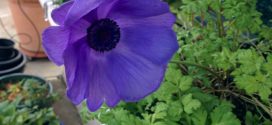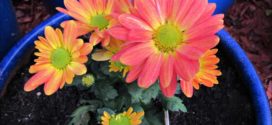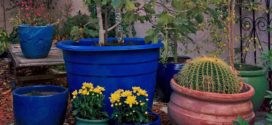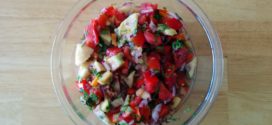Anemones, also known as windflowers, are a diverse group, with various species blooming in spring and fall. Some have fibrous roots and are found in the perennials section of nurseries and garden centers. Others grow from tubers that are sold and planted in the fall along with spring-flowering bulbs like tulips. I first planted these blue anemones in December 2015. …
Read More »admin
This Sunnyvale Garden – November 2016
November is the beginning of winter in our Sunnyvale garden. Summer and fall flowers are putting on their last show. The hummingbird loves the red tubular flowers of the Salvia elegans. Daylilies, yarrow, marigolds, and mums brighten the darkening skies. The hibiscus loves the south-facing wall. Harvested Panache figs, pepino melons, pomegranates, spaghetti squash. Planted garlic, beets, carrots, kale, cabbage, …
Read More »Mums 2016
During the fall, the garden nurseries are full of mums of all varieties. I plant them in a variety of pots.
Read More »Spaghetti Squash
In 2016 we tried growing Spaghetti squash in our Sunnyvale garden. Because we grow almost everything in containers, we got a bush variety (Tivoli) that does not sprawl all that much. Our container was wide but shallow. This resulted in fewer fruit. There is a long time till harvest. Spaghetti squash is a hard gourd, like pumpkin, so you cannot …
Read More »Pineapple 2016
In March 2016, on a whim, I bought a pineapple plant for my Sunnyvale garden. I know. I transplanted it to a larger pot but made the mistake of a too shallow pot. It grew a little and eventually in July we harvested our pineapple. If I was thinking of serving drinks in it, I would only need a shot …
Read More »Meet the new pot – Same as the old pot
This is a photo of a YUGE pot. It holds 66 gallons. For 15 years it held an apple tree but neither the tree nor the pot were satisfied: We rarely got apples. Admitting defeat, I discarded the apple tree; repainted the pot to The Sky Is The Limit Blue; and re-potted our Black Mission Fig tree. This was a …
Read More »Feijoa Habanero Salsa
Feijoa salsa is a great use of the fruit. The tropical aroma and taste of the fruits are complemented by the sweet red onion, the fruity habanero pepper, lemon juice, cilantro and tomatoes. The taste is similar to other fruit salsas like mango, kiwi, or peach. Ingredients: 1 lemon 6 feijoa 1/2 red onion handful of cilantro 1 to 2 …
Read More »Dehydrated Feijoa
It’s October in our Sunnyvale garden so the feijoa tree (aka pineapple guava) is dropping its fruit. I filled a 4 gallon bucket. The fresh fruit has a great taste but a short shelf life of a few weeks. It does not freeze well. In past years I have shared the fresh fruit with friends, family, co-workers, and interested people …
Read More »Pomegranate Harvest 2016
“The sweet fruition of an earthly crown” – Christopher Marlowe Here it is mid-October and the first rains of winter are falling. The pomegranates split open very quickly when wet. For tips on growing: See Pomegranates
Read More »Hatch Chiles
Okay, these chiles are not from my Sunnyvale garden, but I want to share… The official New Mexico state question is “Red or Green?”. The Hatch chile peppers are grown in the Hatch valley, and along the entire Rio Grande, from northern Taos Pueblo to southern Isleta Pueblo, are a signature crop to New Mexico’s economy and culture. The chile …
Read More »








